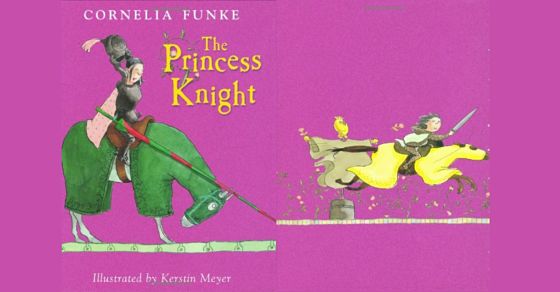- Exclamation Mark
- Dogs Don’t Do Ballet
- Sam and Dave Dig a Hole
- The Most Magnificent Thing
- Private: Touch the Brightest Star
- James Marshall
- Cornelia Funke
- The Book With NO Pictures
- The 20 Best Books for Baby
- 20 Best Books for Pre-readers (3-5 yrs)
- The Best Wordless Books
- Detective Invisible – Kommissar Unsichtbar
- Childrens Books Agatha Christie Loves
- Mr. Murry and Thumbkin
Cornelia Funke belongs to one of those rare breeds of creative people. She started as an illustrator of storybooks and branched out into writing. It’s a wonderful thing that she has, because her stories are fun reads.
As she explains it, Funke would sit down to work on illustrations for different books and find herself bored with the story she had to illustrate. Maybe you can relate to this. Do you write or illustrate in part because you would like to see and read something else?

That’s when Funke decided to start writing her own stories, stories that don’t bore her. Now, she’s a full time writer, and very successful.
Most people probably know her as the creator of Inkheart and The Thief Lord, as both of these were adapted into successful feature films and theatre productions. Both are YA Fantasy Novels (Inkheart is a trilogy). What you might not know is that her illustrated storybooks for younger readers are really fantastic.
I want to talk about one I particularly love, The Princess Knight, which interestingly is NOT illustrated by Funke, but by Kerstin Meyer. (More on that below.)
Being a native German, Cornelia Funke writes her books in German, and then they are translated into various other languages including English. (She has moved to California with her family.)
About Storybook Translations
I find that professional translators are often overlooked and far under appreciated, so I’d like to mention that the translator for the English version is Anthea Bell.
Translating a story is much more difficult than translating a report or some sort of certified documentation. A story translation requires writing finesse, a way of capturing not just the vocabulary and grammar of a story, but of the intention and emotion.
Much can be lost in a translation, but Anthea Bell did a terrific job here.
Not Illustrated by Cornelia Funke?!?!
Though Cornelia Funke is an illustrator, she doesn’t illustrate her own stories. Kerstin Meyer illustrated this story, and her panels are really fantastic. Very cleverly drawn in a way that pulls you right into the action.
I love too the way Meyer has drawn Princess Violetta. She isn’t a fancy, beautiful girl who sings with the birds and bakes lovely pies. She’s just a funny little girl with messy, stringy hair and a pack of brothers to contend with.
So what is this about?
Princess Violetta is a young girl born into a royal family filled with tough princes, but because she’s a girl, she must work extra hard to be as skilled as her brothers. With hard work and determination, she becomes the most skilled knight in her family. As a result, she gets to choose who she will marry rather than have the king decide.
A bit of Nostalgia
This is a simple story that reminds me of the types of stories included in the Free to Be You and Me recording of 1972. (Do you remember that one? GREAT stuff.) Most specifically, the story narrated by Alan Alda and Marlo Thomas, “Atalanta” by Betty Miles came to mind when I first read about Princess Violetta.
That isn’t to say it’s the same story! The themes are completely different and so are the characters. But the feeling of the story and the set-up conjured for me a warm sense of nostalgia. I must have listened to that vinyl record thousands of times, but especially the story about Princess Atalanta.
There weren’t a lot of stories about smart, strong and interesting girls in the 1970s. Usually, female characters were thin-lipped blondes who were really kind of boring (or even stupid). No one looked anything like me and the only interesting characters were male. It’s so wonderful to see how that is changing!
About Stereotypes for Girls
My daughter has her pick of great stories about strong and interesting girls, and at last we have girls who are intelligent without needing to be written off as overly intellectual. Girls can be athletic without being tomboys.
I always hated those stereotypes and I’m glad to see that they’re growing obsolete. Not for my generation, but perhaps for my daughter’s daughter they might be.
Thanks to writers like Cornelia Funke, who write stories about interesting girls, I know that the youngest generation of girls has many more inspiring and fun stories to enjoy.
What do you love?
Do you feel like there are storybooks on the market that reflect you, your interests and your culture? What are they – and do they really hit the mark for you (or just almost)? Write below, let me know – or just send me an email. I’m always looking for more great books and would love to hear from you.
Keep creating (and keep reading) – no matter what.

--Download Cornelia Funke as PDF --



